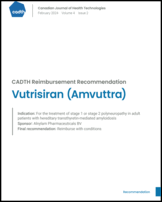|
Neurologic impairment
|
|---|
| Percent of patients with PND score 1. “improvement” 2. “no change” 3. “worsened” Follow-up: 18 months | 164 (1 RCT) | NR | 1. | || || || | 2. | || || || | 3. | || || || | | 1. | || || || | 2. | || || || | 3. | || || || | | 1. | || || || | 2. | || || || | 3. | || || || | | 1. Lowd,f,h,i 2. Very lowe,f,h,i 3. Very lowe,f,h,i | Vutrisiran may result in more patients with a PND score of “improvement” when compared with patisiran. The evidence is very uncertain about the effects of vutrisiran on the PND scores of “no change” and “worsened” vs. patisiran. There is some uncertainty about the clinical importance of the estimates. |
| mNIS+7: LS mean (SE) change from baseline (0 [best] to 304 [worst]) Follow-up: 18 months | 148 (1 RCT) | NR | 1.53 | 0.06 (SE to 1.48) | −1.46 (−7.36 to 4.43) | Moderatea,f,i | Vutrisiran likely results in little to no difference in mNIS+7 when compared to patisiran. There is some uncertainty about the clinical importance of the estimates. |
|
Functional impairment
|
|---|
| R-ODS score: LS mean (SE) change from baseline (48 [best] to 0 [worst]) Follow-up: 18 months | 151 (1 RCT) | NR | −1.3 | −1.2 (SE to 0.5) | 0.1 (−2.0 to 2.2) | Moderateb,f,i | Vutrisiran likely results in little to no difference in R-ODS scores when compared to patisiran. |
|
HRQoL
|
|---|
| Norfolk QoL-DN score: mean (SE) change from baseline (−4 [best] to 136 [worst]) Follow-up: 18 months | 149 (1 RCT) | NR | −0.8 | −2.5 (SE to 1.8) | −1.6 (−8.6 to 5.4) | Moderatec,f,i | Vutrisiran likely results in little to no difference in Norfolk QoL-DN score when compared to patisiran. |
|
Serum TTR
|
|---|
| Serum transthyretin: percent change from baseline, median Follow-up: 12 months (month 6 to month 18) | 160 (1 RCT) | NR |
| || || || |
| | || || || | (NR) | 5.28 (1.17 to 9.25) | Highg | Vutrisiran results in little to no clinically important difference (i.e., a noninferior effect) for serum TTR when compared to patisiran. |
|
Harms
|
|---|
| Mortality Follow-up: 18 months | 164 (1 RCT) | NR |
| || || || |
|
| || || || || || || || || || || || |
|
| || || || || || || || || || || || || || || || |
| Very lowd,f,h,j | The evidence is very uncertain about the effects of vutrisiran on mortality vs. patisiran. |
